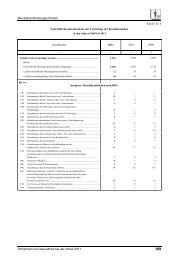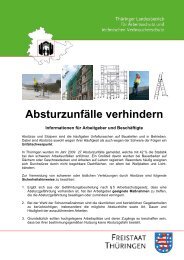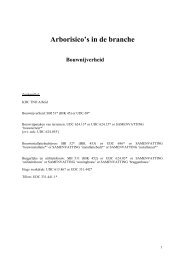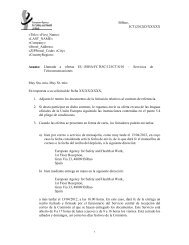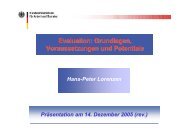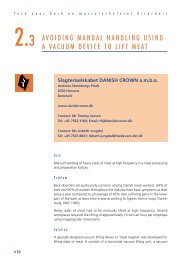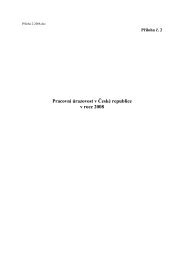ESENER-PSR 2009 - European Agency for Safety and Health at Work
ESENER-PSR 2009 - European Agency for Safety and Health at Work
ESENER-PSR 2009 - European Agency for Safety and Health at Work
You also want an ePaper? Increase the reach of your titles
YUMPU automatically turns print PDFs into web optimized ePapers that Google loves.
The finally reached net sample <strong>for</strong> the <strong>ESENER</strong> <strong>2009</strong> shows the following distributions over<br />
the 10 cells of the sampling m<strong>at</strong>rix:<br />
Table 1.3.3.1: Net sample <strong>ESENER</strong> <strong>2009</strong><br />
1. Producing Industries<br />
(NACE Rev. 1.1 C-F resp.<br />
NACE Rev.2, B-F)<br />
2. Service Sector<br />
(NACE Rev. 1.1 G to O<br />
resp. NACE Rev.2, G-S)<br />
10 – 19 employees 10% 15%<br />
20 – 49 employees 11% 16%<br />
50 – 199 employees 12% 17%<br />
200 – 499 employees 5% 5%<br />
500 + employees 4% 5%<br />
Within the single cells of this disproportionally str<strong>at</strong>ified sampling m<strong>at</strong>rix, addresses were<br />
drawn strictly <strong>at</strong> r<strong>and</strong>om.<br />
1.3.4 Challenges <strong>for</strong> the weighting of the <strong>ESENER</strong><br />
For a disproportional sample design like the one chosen <strong>for</strong> the <strong>ESENER</strong> <strong>2009</strong>, a posterior<br />
weighting of the d<strong>at</strong>a is indispensable. Weighting as dem<strong>and</strong>ed according to the tender<br />
specific<strong>at</strong>ions set out by the <strong>European</strong> <strong>Agency</strong> required the availability of a set of st<strong>at</strong>istical<br />
figures on the universe of the survey <strong>for</strong> each country:<br />
In<strong>for</strong>m<strong>at</strong>ion on the distribution of establishments by size class <strong>and</strong> sector of activity<br />
Figures on the distribution of employees by size class <strong>and</strong> sector of activity, i.e.<br />
in<strong>for</strong>m<strong>at</strong>ion on how many employees work in all establishments of a certain size class<br />
<strong>and</strong> sector of activity.<br />
The main challenges with respect to the weighting consisted in the collection of the required<br />
st<strong>at</strong>istical background in<strong>for</strong>m<strong>at</strong>ion, in the assessment of the quality <strong>and</strong> suitability of this<br />
in<strong>for</strong>m<strong>at</strong>ion <strong>and</strong> in the design of measures on how to cope with detected weaknesses in the<br />
available st<strong>at</strong>istical d<strong>at</strong>a. The way how these challenges were dealt with is described in detail<br />
in chapter 3 of this report.<br />
1.4 In<strong>for</strong>m<strong>at</strong>ion in address-registers: Size-class <strong>and</strong> sector of activity<br />
For sampling as considered desirable according to the <strong>European</strong> <strong>Agency</strong>’s call <strong>for</strong> tenders <strong>for</strong><br />
the <strong>ESENER</strong> <strong>2009</strong>, address registers were needed th<strong>at</strong> comprise:<br />
addresses <strong>at</strong> establishment level,<br />
all sectors of activity (with some minor exceptions, compare 1.5.),<br />
up-to-d<strong>at</strong>e in<strong>for</strong>m<strong>at</strong>ion on the sector of activity,<br />
15





